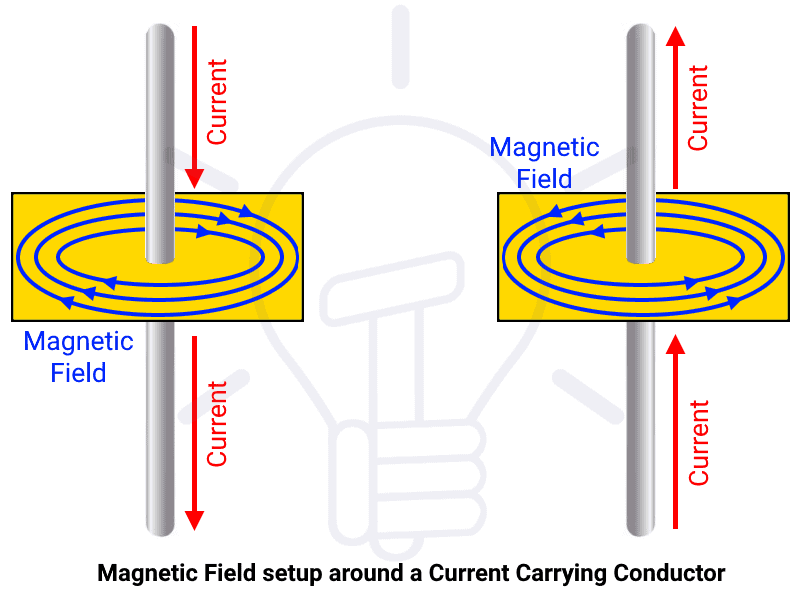Oersted’s Law of a Magnetic Field of a Straight Current Carrying Conductor
Oersted’s Law of Electromagnetism – Its Formula and Applications
What is Oersted’s Law?
A Danish physicist Hans Christian Ørsted discovered the relation between electricity and magnetism on 21 April 1820 known as Oersted’s law which states that “Electric current creates a magnetic field surrounding it“.
The Oersted experiment has a strong influence on Joseph Henry and Michael Faraday and after exploring the magnetic effect of current in a deeper sense which led them to lay the foundation of the modern electrical machinery.
After many experiments, Oersted found that a straight current carrying conductor induces a magnetic field where the direction of magnetic field depends on the direction of flowing current in the conductor. The direction of the magnetic field can be found by the right hand thumb rule or Fleming’s left & right hand rules.

In simple words, Oersted found the following points for a straight current carrying conductor.
- A current carrying conductor creates a magnetic field around it.
- The magnetic field lines of force (created by current) encircle the current carrying conductor.
- The magnetic field lines of force (created by current) lie in a plane perpendicular to the conductor (i.e. at right angle (90°) to each other).
- The change in the direction of flow of current will also change the direction of magnetic field lines of force.
- The magnetic field strength is directly proportional to the current density.
- The magnetic field strength at a point is inversely proportional to the distance of that point from the current carrying wire.
- The magnetic field exists around the wire until the flow of current is abandoned.

Ørsted’s magnetic compass experiment (which detected that straight electric current creates a straight magnetic field) confirms the following facts as well.
- If two parallel current carrying conductors have the same current but opposite in direction, the resultant magnetic field will be zero. This is because both magnetic fields have opposite polarities and repel each other.
- If two parallel current carrying conductors have the same current and direction, the resultant magnetic field will be doubled. This is because both magnetic fields have the same polarity and attract each other.
- The magnetic effect is directly proportional to the flowing current in the conductor.
Good to know: The equation of Ørsted’s Law only applicable to Direct Current (DC) circuits with no inductors and capacitors. In other words, it fails in an Alternating Current (AC) circuit consisting of a battery charging a capacitor through a resistor.

Formula and Equation of Oersted’s law
Oersted’s law can be described in the vector form as follows.
∮C B dl = μo I
or
∮C B dl = μo ∫∫s J . dS
Where:
- B = Magnetic Field
- I = Current
- ∮C = Line integral around a closed curve
- J = Current density
- S = Surface
- Absolute permeability = μo = 4π×10-7 H/m

Applications of Oersted’s law
As listed as one of the Maxwell’ Equation (Ampere-Maxwell equation or Maxwell-Faraday equation), Oersted experiments laid the foundation of advance electrical machinery systems such as:
- Electric Motors.
- Electric Transformers.
- Electric Generators and alternators.
- Headphones, microphones and tap record players.
- Magnetometers and musical instruments such as electric guitar etc.
- Digital Microcontrollers and Microprocessors.
Related Posts:
- What is Faraday’s Law? Laws of Electromagnetic Induction
- Coulomb’s Laws of Magnetic Force – Formula & Solved Example
- What is Coulomb’s Law? Laws of Electrostatics With Example
- Lenz’s Law of Electromagnetic Induction
- Kirchhoff’s Current & Voltage Law (KCL & KVL) | Solved Example
- Ohm’s Law with Simple Explanation
- What is Joule’s Law and Heating Effect of Current






